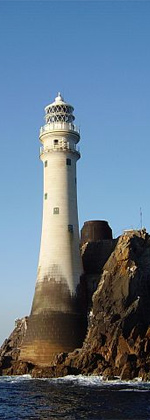 Ballycotton Lighthouse | |
 | |
| Location | Ballycotton Island, County Cork, Ireland |
|---|---|
| Coordinates | 51°49′33″N7°59′03″W / 51.825737°N 7.984159°W |
| Tower | |
| Constructed | 1848 |
| Construction | granite tower |
| Automated | 1991 |
| Height | 15 m (49 ft) |
| Shape | cylindrical tower with balcony and lantern |
| Markings | black tower, red balcony |
| Operator | Commissioners of Irish Lights |
| Light | |
| First lit | 1 June 1851 |
| Focal height | 59 m (194 ft) |
| Lens | catadioptric prism (fixed inner), annular lenses (rotating outer) |
| Range | 21 nmi (39 km; 24 mi) (white), 17 nmi (31 km; 20 mi) (red) |
| Characteristic | Fl WR 10s |
| Ireland no. | CIL-0290 |
Ballycotton Lighthouse is an active 19th century lighthouse positioned on Ballycotton Island, east of Ballycotton, County Cork, on the south coast of Ireland. [1] The lighthouse, which is maintained by the Commissioners of Irish Lights, [2] is described by the National Inventory of Architectural Heritage as "a significant addition to the historical record and maritime heritage of Ireland". [3]
Contents
It is one of only a handful of lighthouses in the world painted black, which was chosen to distinguish it from Capel Island's (unlit) beacon. [4] [5] [6] [7] Capel Island is where the lighthouse was initially to be located, but ultimately a decision was made to build it on Ballycotton Island. [8] It is also one of few examples of lighthouses featuring some of the lower panes made of red glass with the consequence that ships approaching too close to land may be warned by an apparent change of colour. [9]


